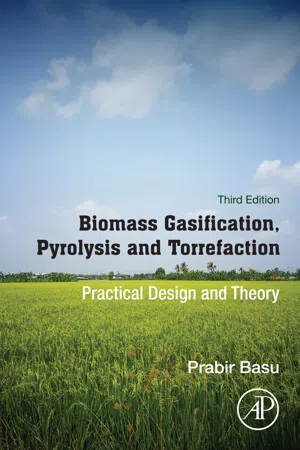
- 582 pages
- English
- ePUB (mobile friendly)
- Available on iOS & Android
About this book
Biomass Gasification, Pyrolysis and Torrefaction, Third Edition, is enhanced with a new topic on processing and cleaning of product gas of gasification and a brief introduction to biomaterials, making it a versatile resource that not only explains the basic principles of energy conversion systems, but also provides valuable insight into the design of a complete biomass conversion systems. With a dedicated focus on the design, analysis and operational aspects of biomass gasification, pyrolysis and torrefaction, this edition offers comprehensive coverage of biomass in its gas, liquid or solid states in a single accessible source.The author provides many worked design problems, step-by-step design procedures and real data on commercially operating systems. Although the book carries the name 'biomass', the bulk of its content is also applicable to non-biomass fuels like coal, petcoke, municipal solid waste and others. This book will help engineers, scientists and operating personnel of biomass gasification, pyrolysis or torrefaction plants, gain better comprehension of the basics of biomass conversion.Biomass Gasification, Pyrolysis and Torrefaction, Third Edition, is enhanced with a new topic on processing and cleaning of product gas of gasification and brief introduction to biomaterials making it a versatile resource that not only explains the basic principles of energy conversion systems, but also provides valuable insight into the design of a complete biomass conversion systems. With a dedicated focus on the design, analysis, and operational aspects of biomass gasification, pyrolysis, and torrefaction, this edition of the book offers comprehensive coverage of biomass in its gas, liquid, or solid states in a single easy-to-access source. The author provides many worked out design problems, step-by-step design procedures and real data on commercially operating systems. Although the book carries the name 'biomass', the bulk of its content is also applicable to non-biomass fuels like, coal, petcoke, municipal solid waste and others. This book will allow professionals, such as engineers, scientists, and operating personnel of biomass gasification, pyrolysis or torrefaction plants, to gain a better comprehension of the basics of biomass conversion.- Features updates with the most recent research and technology- Expanded to include a new chapter on syngas purification- Contains step-by-step process flow diagrams, design data, conversion charts and numerical examples with solutions- Provides available research results in an easy-to-use design methodology- Examines the economic aspects of biomass conversion
Frequently asked questions
- Essential is ideal for learners and professionals who enjoy exploring a wide range of subjects. Access the Essential Library with 800,000+ trusted titles and best-sellers across business, personal growth, and the humanities. Includes unlimited reading time and Standard Read Aloud voice.
- Complete: Perfect for advanced learners and researchers needing full, unrestricted access. Unlock 1.4M+ books across hundreds of subjects, including academic and specialized titles. The Complete Plan also includes advanced features like Premium Read Aloud and Research Assistant.
Please note we cannot support devices running on iOS 13 and Android 7 or earlier. Learn more about using the app.
Information
Introduction
Abstract
Keywords
1.1 Biomass and Its Products
Table of contents
- Cover
- Title page
- Table of Contents
- Copyright
- Dedication
- Preface
- Acknowledgments
- Chapter 1: Introduction
- Chapter 2: Economic Issues of Biomass Energy Conversion
- Chapter 3: Biomass Characteristics
- Chapter 4: Torrefaction
- Chapter 5: Pyrolysis
- Chapter 6: Tar Production and Destruction
- Chapter 7: Gasification Theory
- Chapter 8: Design of Biomass Gasifiers
- Chapter 9: Hydrothermal Conversion of Biomass
- Chapter 10: Cleaning of Product Gas of Gasification
- Chapter 11: Biomass Combustion and Cofiring
- Chapter 12: Production of Synthetic Fuels and Chemicals from Biomass
- Chapter 13: Biomass Handling
- Chapter 14: Analytical Techniques
- Appendix A: Definition of Biomass
- Appendix B: Physical Constants and Unit Conversions
- Appendix C: Selected Design Data Tables
- Glossary
- Bibliography
- Index